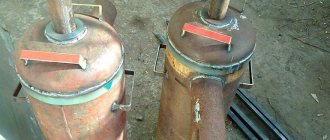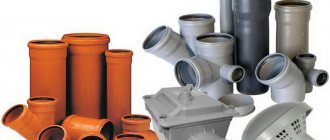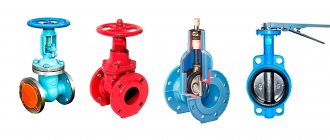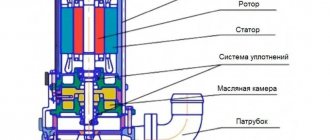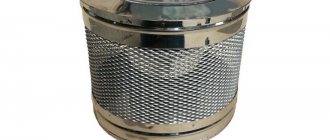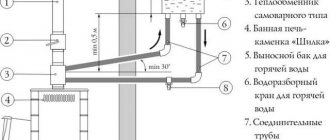Boiler or furnace: differences in designs
Sometimes a sauna boiler is called a stove; confusion occurs when it comes to the simplest products that burn wood or briquettes. In reality, boilers are more complex: a stove with a chimney is complemented by a tank for heating water and (sometimes) a heat exchanger.
To maximize the effect of bath procedures, a visit to the bath necessarily includes washing before the steam room and rinsing after it. Installing a tank allows you to get a productive water heating device; however, the modification increases the cost slightly.
The sauna boiler comes with a water tank. It is especially practical where the steam room and washing compartments are combined. It is able to provide rapid heating of water thanks to a heat exchanger. To ensure maximum heat transfer, water circulation occurs in different directions. Structurally, the tank can occupy several positions, but it always makes the most of the potential of the heating equipment.
Construction of a wood stove with a tank Source aviarydecor.com
Installing a gas boiler in a bathhouse with your own hands
Before connecting the equipment, it is necessary to obtain the appropriate permits and approve the project with the authorities. Develop a gas supply project in a specialized service, and then send it and accompanying documents for approval, for example, to Gorgaz. You will need papers from the manufacturer: equipment data sheet, instructions, certificate of conformity.
Work with gas equipment is carried out by specialists in accordance with accepted rules and regulations: SNiP 42-01-2002 and II-35-76, set of rules: SP-41-104-2000. They provide a detailed description of how to properly perform this work, and what is strictly prohibited from doing. For example, the diameter of the chimney is selected in accordance with the power of the device using special formulas.
Wall-mounted gas boilers for heating water
Having received the necessary permits, you can begin work: install a gas pipeline and water supply, line the wall with fire-resistant material, make a hole for the chimney.
- Flush the device's pipe systems.
- Attach wall-mounted equipment to the slats.
- Make holes in the wall, secure the planks with anchors or self-tapping screws.
- Secure the boiler to the mounting strips.
- Attach taps and filters to the pipes;
- Connect the taps at the inlet and outlet;
- Install squeegees;
- Connect the heating system;
- Connect the squeegee to the heating;
- Connect the water supply;
- Connect the chimney.
A separate room is allocated for floor equipment. The walls and floor are covered with special fireproof materials. The unit is screwed to the floor. The rest of the connection diagram is identical to the wall-mounted version.
Design options for sauna boilers
The design differences lie mainly in the method of placing the tank and the volume of heated water. The classification covers four installation methods; they all have their own merits and are equally widespread throughout Russia.
Internal tank
The design, in which the water heating tank is located inside the furnace body, is interesting for the following features:
- There is no access to the tank from the outside; it is not visually visible. In most cases, the solution is typical for factory models.
- The internal location ensures maximum water heating speed when compared with other varieties. The container is in direct contact with the combustion chamber; Additionally, the housing prevents heat from leaking out.
- As a rule, such models have a small (25-30 l) volume. They are ergonomic, efficient and keep water warm for a long time.
Model with a compact internal tank Source dekoriko.ru
On the chimney, "samovar"
The water reservoir is located on the chimney, in close proximity to the stove (above it). The samovar tank is a practical solution for hot water supply with the following specifics:
- Heating occurs due to exhaust furnace gases, which significantly increases the overall efficiency of the device. The water remains hot both during combustion and for some time after its completion.
- The solution is considered environmentally friendly and economical if you need to organize hot water supply for a periodically used room.
- The water heats up more slowly than in a design with an internal tank, but the heating speed is sufficient for comfortable use. Productivity depends on the power of the stove and the volume of the tank.
- Heating occurs due to the fact that thermal energy comes not only from the walls of the chimney, but also from the metal body.
- The efficiency of the device can be increased: the closer the tank is located to the furnace (the source of hot furnace gases), the faster the water temperature rises.
Medium volume samovar tank Source prom.st
- The design is reliable, easy to install and maintain. The tank is made of stainless steel and has a rectangular or round shape (at the base).
Remote with heat exchanger
The steel tank is located outside the sauna stove, but is connected to it by a heat exchanger built into the firebox. The system can be described as follows:
- The flame in the firebox first heats the coolant in the heat exchanger (a water circuit built into the firebox), and only then heats the water in the tank.
- There are no restrictions on tank volume in the design. The heat exchanger coil is built directly into the firebox.
- The presence of an intermediate link is the reason for the rather slow rate of increase in water temperature (the slowest of all options).
- High-quality heat-resistant steel is used to manufacture the remote tank. The volume is selected based on the size of the room, usually 35-80 liters. Containers of increased volume (60-80 l) can be angular.
- In order for the water circuit to work with maximum efficiency, the tank is not moved more than 2.5 m from the stove.
Design with a remote tank Source aviarydecor.com
- Despite the slow heating, the remote design is popular. The fact is that if you install it in the washing compartment, you can additionally heat the room.
- The full heating time is affected by the volume of the container and the external temperature. With a volume of 80 liters, heating will take approximately 2.5-3 hours.
See also: Catalog of companies that specialize in engineering systems (heating, water supply, sewerage and others) and related work
Mounted (a type of remote)
A mounted boiler in a bathhouse has the following advantages:
- The metal container is attached to the furnace body, on the side or back, rigidly or using special connectors. Close proximity is the main feature of the design.
- Contact with the hot furnace body (steel, cast iron or brick) ensures a rapid increase in the temperature of the coolant.
- The design is simple in design and installation. It is manufactured as a separate component, so you can refuse to use it if you wish.
- Disadvantage of a metal tank: it is located near people, which increases the likelihood of careless touching and burns.
Wood-burning stove with a hanging tank Source oteplicax.ru
Material of construction
Separately, it is necessary to note the classification of materials used for the manufacture of units.
Cast iron boilers for baths are used quite rarely. Not used in steam rooms. Installed only in separate rooms. Such sauna boilers are suitable for heating water and heating.
The following products are used for steam rooms:
- metal;
Metal boiler
- metal with brick lining;
Metal boiler lined with brick
- brick.
Brick boiler for a bath
The first option can be purchased ready-made, while the other two require the participation of professionals to be manufactured on site. As a result, each type will cost a lot. Therefore, many people try to make a boiler for a bath with their own hands. Of course, this activity is fraught with certain difficulties and requires time and financial costs, but using the unit you have made will be much more pleasant, because it is made with your own hands.
Sauna stove with removable hatch
Types of boilers by type of energy carrier
Most private baths are modest in size and heated using a simple wood stove, often supplemented by a water tank. Wood-burning sauna boilers are classified as solid fuel units. The boiler is installed simultaneously with the stove during the construction of the bathhouse. Wood-burning models are often the work of their owners, unlike devices that run on another type of energy source.
Electric boilers
They are designed for heating any premises: country houses, apartments, dachas and other objects. The operating principle of an electric boiler is the same as that of a boiler. By design, there are two-circuit boilers (they simultaneously heat and supply hot water) and single-circuit boilers (they exclusively heat).
Compared to units using other types of fuel, electric boilers are safer and operate silently in automatic mode. They are distinguished by their neat dimensions and light weight. The advantages include simpler and cheaper connection, simpler operation. Most models are wall-mounted; they do not need a personal boiler room; installation is possible in any room.
Model of an electric boiler with a water tank Source teplodar.ru
For use in bathhouse conditions, it is important that electric boilers do not create harmful emissions; they do not require regular cleaning and the purchase of fuel. Despite its obvious environmental friendliness, an electric unit is far from the most successful option for a bathhouse; They are rarely used for the following reasons:
- High energy consumption.
- High demands on network stability, as well as on the quality and reliability of electrical wiring.
An electric boiler is chosen if the bathhouse is located in the basement of the house or adjacent to it. In a free-standing bathhouse, limit yourself to a boiler or choose a compact single-circuit boiler to provide hot water supply for the washroom.
Gas
A gas boiler for a bath is becoming a competitor to traditional wood-burning stoves. Installing such a unit is economically beneficial not only in gasified areas. If you want to equip a bathhouse in your country house, but there is no mains for connection nearby, the solution may be a device that can run on liquefied gas rather than natural gas.
Gas boilers are reliable and economical Source 2proraba.com
Main types of boilers and their advantages
Today there are several types of heating boilers on the market:
- electrical;
- gas;
- diesel;
- solid fuel;
- universal (multi-fuel).
Multi-fuel boilers can operate on several types of fuel at once. Examples of combinations include: gas, electricity and liquid fuel; gas and diesel fuel; gas, liquid and solid fuel, etc.
Each of these options has its own advantages:
- Electric models combine quiet operation, ease of installation and the absence of flame, which significantly increases safety.
- Gas ones offer high power, efficiency, small dimensions and a fairly large heating area.
- Solid fuel. They are environmentally friendly, increased energy efficiency and, importantly, they do not depend on the availability of a source of electricity. Accordingly, you can save on electricity.
- Diesel. They have good power and are not dependent on the presence of a heat or gas main. If necessary, you can switch from diesel fuel to gas.
Making a wood boiler
If you know how to use a welding machine, an angle grinder and have spatial imagination, a homemade boiler for a bathhouse can be a budget alternative to purchased models. Self-assembly does not involve complex techniques and does not require expensive materials.
Diagram of a boiler with a water circuit Source sitysun.ru
How to choose a boiler for a bath or sauna
If you find it difficult to determine what tank size will be optimal for the conditions of your bath, it is useful to use the following considerations:
- To steam one broom, it takes at least 10 liters of hot water, for two you will need 20 liters.
- For comfort, every connoisseur of bath procedures needs at least 15, and preferably 20, liters of heated water.
If a company of four people gathers, then the tank volume should be at least 80 liters (based on two brooms).
For the unit to operate efficiently, it is also important to take into account personal needs and correlate them with the following parameters:
- Dimensions and power of the boiler, what volume of the steam room it is designed for.
- From which room according to the project will the steam room be heated?
- Materials of the device, especially the housing.
- Type of heater, volume of stones.
- If you are planning a gas bath, one of the criteria will be gas pressure, as this is important for the safe operation of the device.
- Will you line the container with stone, tile or brick to better retain heat and protect you from burns.
Modern oven with a heat exchanger and an external tank Source ukr.bio
Briefly about the main thing
Many owners of baths and saunas consider it optimal to use a boiler, that is, a stove supplemented with a water tank. This combination is practical and functional; it provides not only hot water supply for any bath processes, but also helps to heat the premises.
There are several ways to position the tank, based on whether it will be built-in or external. To a large extent, the choice of boiler model is influenced by whether gas, electricity or wood will be used as fuel. The volume of the tank is selected depending on the number of users.
Ratings 0

